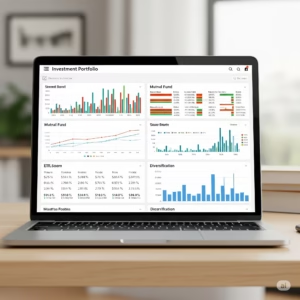5 indicators you should look at before buying a stock
Know these 5 indicators before investing in stocks

Thinking about diving into the stock market? It’s exciting, but rushing in without a plan can be risky. Before you click “buy” on that promising stock, it’s crucial to do your homework. You don’t need to be a financial wizard to understand the basics. This article will break down five key indicators that even a beginner can use to make smarter investment decisions. These simple checks can help you identify potentially strong companies and avoid common pitfalls.
Understanding Price-to-Earnings (P/E) Ratio: Is the Stock Overpriced?

One of the most fundamental metrics for stock analysis is the Price-to-Earnings (P/E) Ratio. In simple terms, it tells you how much investors are willing to pay for each dollar of a company’s earnings.
- How to calculate it: Divide the current stock price by the company’s earnings per share (EPS) over the past 12 months.
- What it means for you: A high P/E ratio might suggest that the stock is overvalued or that investors expect high future growth. A low P/E ratio could indicate an undervalued stock or a company with slower growth prospects.
Debt-to-Equity (D/E) Ratio: How Much Debt Does the Company Have?
While debt isn’t inherently bad for a company, too much of it can be a red flag. The Debt-to-Equity (D/E) Ratio reveals how much debt a company is using to finance its assets compared to the value of its shareholders’ equity.
- How to calculate it: Divide a company’s total liabilities by its shareholders’ equity.
- What it means for you: A high D/E ratio means the company relies heavily on debt. This can be risky, especially during economic downturns, as it might struggle to meet its obligations. A lower D/E ratio generally indicates a more financially stable company.
Return on Equity (ROE): How Efficiently Is the Company Using Your Money?

As an investor, you want to know if the company is effectively using the money shareholders have invested. That’s where Return on Equity (ROE) comes in. It measures how much profit a company generates for each dollar of shareholders’ equity.
- How to calculate it: Divide a company’s net income by its shareholders’ equity.
- What it means for you: A higher ROE typically indicates that the company is very efficient at turning shareholder investments into profits. Consistent and high ROE is often a sign of a well-managed and profitable business.
Dividend Yield: Is the Company Sharing Its Profits?
For income-focused investors, Dividend Yield is a crucial indicator. It shows how much a company pays out in dividends relative to its stock price. Dividends are essentially a portion of the company’s profits distributed to shareholders.
- How to calculate it: Divide the company’s annual dividend per share by its current share price.
- What it means for you: A higher dividend yield means you’re getting a larger percentage return in the form of cash payments. Companies that consistently pay and grow their dividends are often mature, stable businesses.
Earnings Per Share (EPS) Growth: Is the Company’s Profitability Increasing?
Ultimately, companies need to grow their profits to increase shareholder value. Earnings Per Share (EPS) Growth tells you whether a company’s profitability is expanding over time.
- How to calculate it: Compare the current EPS to previous periods (e.g., year-over-year, quarter-over-quarter).
- What it means for you: Consistent positive EPS growth is a strong indicator of a healthy, expanding business. It suggests the company is effectively increasing its revenue or managing its costs. Declining or stagnant EPS growth can be a warning sign.
Empower Your Investment Journey

By understanding and utilizing these five key indicators—P/E Ratio, Debt-to-Equity Ratio, Return on Equity, Dividend Yield, and EPS Growth—you’ll be much better equipped to make informed decisions before buying a stock. Remember, no single indicator tells the whole story. Always use them in conjunction with each other and consider the company’s overall business model, industry trends, and future prospects. Happy investing!





